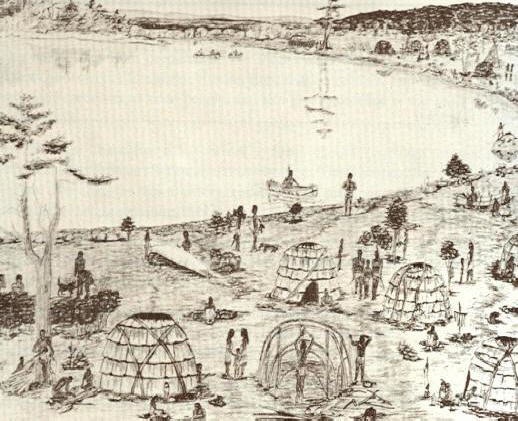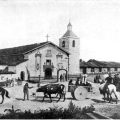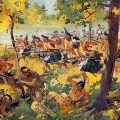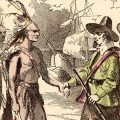
While the Indian nations in what is now Maine may have had some limited contact with Europeans as early as 1480, regular contact began in the sixteenth century and intensified during the first half of the seventeenth century. During this time, the Indians began to incorporate aspects of European culture, such as trade goods, into their own lifestyles. These early contacts were with four broad categories of Europeans: fishermen, explorers, missionaries, and colonists.
Fishermen
By 1519, European fishing boats were trading with the Micmac in Maine and the Maritime Provinces. By 1524, ships were crossing over from Europe in increasing numbers, first to fish offshore for the great schools of cod, and eventually to trade with natives for furs.
During the early part of the seventeenth century, English ships scouted the coast from Maine to Cape Cod, trading with Indians and gathering sassafras roots which were prized in Europe as a treatment for syphilis. In 1602, off the coast of Maine, the crew of an English ship saw people in a European boat – described as a Biscay shallop – sailing toward them. They assumed that the eight men in it must be Europeans. However, all were Indians. The Indians, using a piece of chalk, drew a map of the Maine coast for the newly arrived English sailors.
Sailing shallops could be fairly large: up to 12 tons and forty feet in length. Many had more than one mast. Regarding the adaptation of this craft by Indian people, the Jesuit missionaries noted that the Souriquois handled them “as skillfully as our most courageous and active sailors in France.” Some writers feel that the Indians had acquired the shallops from the Basque fishermen who had a history of fishing in the area.
There are a number of other reports of Indians using the European shallops. In 1606, for example, the Souriquois under the leadership of Membertou raided other Indian villages using sailing shallops. The following year, the English on their way to establish their colony on the Kennebec River encountered two sailing shallops being used by Souriquois under the leadership of Membertou. The Souriquois offered skins for trade and the English noted that the Indians seemed to be using a lot of French words.
Explorers:
Giovanni da Verrazano, an Italian working for the French, explored the North America coast from the Carolinas northward to Maine in 1524. In Maine, Verrazano found that the Indians were not particularly friendly. They appeared to have already had some contact of an unpleasant sort Europeans, perhaps Europeans who were fishing off the coast. While Verrazano did not speak any Indian languages, he concluded:
“We think they have neither religion nor laws.”
According to Barbara Mann, in her essay in Debating Democracy: Native American Legacy of Freedom:
“What Verrazano, and all European observers after him, meant by lack of ‘any law’ in Native America was the absence of any controlling church-state hierarchy.”
The following year, a Spanish expedition led by the Portuguese pilot Estévan Gomes landed near the River of Deer in Maine and took 58 Indians captive.
In 1580, the English adventurer John Walker landed in Penobscot Bay. He took about 300 moose hides from an unattended building. In their chapter in American Beginnings: Exploration, Culture, and Cartography in the Land of Norumbega, Bruce Bourque and Ruth Whitehead report:
“It may be inferred that such a large concentration in a single structure meant that the hides were intended not for the local population but for export, ultimately to Europeans; but Walker provided no further clue as to their intended destination.”
In 1602, the English explorer Bartholomew Gosnold landed at “Savage Rock” (Cape Elizabeth) where he encountered some Micmac. Geographer G. Malcolm Lewis, in his chapter in North American Exploration. Volume 1: A New World Disclosed, reports:
“From aspects of their dress and a few of the words they spoke, they appeared to have had some previous contact with Europeans.”
The European explorers found that the Indians were wearing large copper breastplates and European costumes including shoes, waistcoats, breeches, and hose. The following year, English explorers under the leadership of Martin Pring encountered a group of Indians near present-day Saco. They reported that some of the Indians had brass breastplates which were a foot long and about half a foot wide.
In 1604, the French explorer Samuel de Champlain sailed up the Penobscot River. Near the site of present-day Bangor, he made contact with the Wabanaki under the leadership of Bashabes. From Bashabes the French learned a great deal about the interior of Maine. Bashabes, wanting French partnership in the fur trade, provided Champlain with guides. While the French were looking for the fabled Indian city of Norumbega, they found that the city was a myth. The French did, however, gain a great deal of information about the interior between Kennebec Basin and the St. Lawrence. Getting around the language barrier, the Indians drew maps on sand and bark for the French.
The French next explored Saco Bay where they saw and recorded on their chart an Indian corn-growing settlement. On the Saco River they were met by Indians who painted their faces black and red. The Indians were a farming people who raised corn, beans, squash, pumpkins, grapes, and tobacco. Champlain’s Etchemin guides called the people at this village Archmouchiquois and they called the village Chouacoit. The area surrounding the village contained many small hamlets.
In 1609, Henry Hudson met with Indians in Penobscot Bay. The Indians told him that they traded with the French. A few days later, two French shallops filled with Indians sailed into the harbor bringing many beaver skins and other furs for trade. Hudson was not equipped for trade, so he simply resorted to force to obtain the furs. His men captured one of the shallops and took the Indian furs.
In 1614, John Smith, the former commander at Jamestown, led two ships in search of gold and whales along the coast of Maine. They did some trading with the natives and engaged in a few skirmishes. Like other European explorers, they captured some Indians to sell into slavery.
Disease
One of the unintended consequences of contact between Europeans and Indians was epidemic disease which often decimated the Indian populations. In 1610, an epidemic struck the Souriquois at La Have taking at least 60 lives.
The first of three epidemics struck the Indians of New England in 1616. It is estimated that 75% of the population died between 1616 and 1619. The epidemics swept from Cape Cod to the Kennebec River in Maine. The epidemics started after an English party wintered at the mouth of the Saco River. While it is not known what the actual diseases were, various historians have suggested bubonic plague, smallpox, and hepatitis A as possibilities.
A new disease which produced bloody vomiting broke out among the Abenaki in 1646. This outbreak may have contributed to Jean-Baptiste’s missionary success.




Leave a Reply